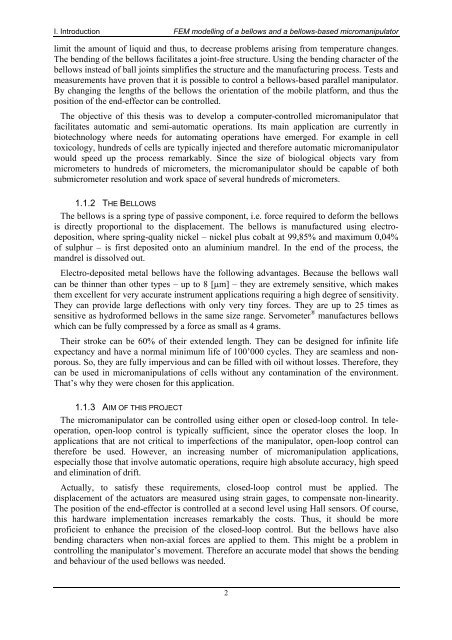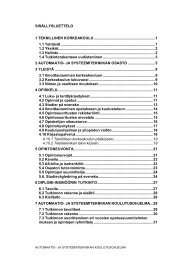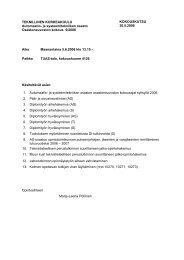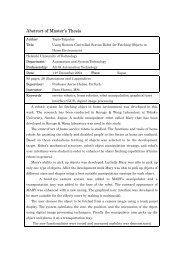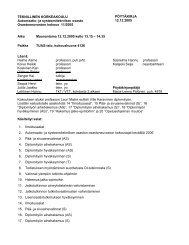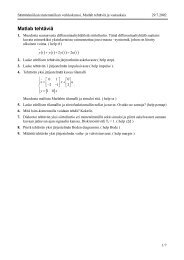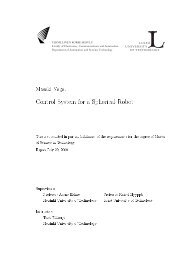fem modelling of a bellows and a bellows- based micromanipulator
fem modelling of a bellows and a bellows- based micromanipulator
fem modelling of a bellows and a bellows- based micromanipulator
You also want an ePaper? Increase the reach of your titles
YUMPU automatically turns print PDFs into web optimized ePapers that Google loves.
I. Introduction FEM <strong>modelling</strong> <strong>of</strong> a <strong>bellows</strong> <strong>and</strong> a <strong>bellows</strong>-<strong>based</strong> <strong>micromanipulator</strong>limit the amount <strong>of</strong> liquid <strong>and</strong> thus, to decrease problems arising from temperature changes.The bending <strong>of</strong> the <strong>bellows</strong> facilitates a joint-free structure. Using the bending character <strong>of</strong> the<strong>bellows</strong> instead <strong>of</strong> ball joints simplifies the structure <strong>and</strong> the manufacturing process. Tests <strong>and</strong>measurements have proven that it is possible to control a <strong>bellows</strong>-<strong>based</strong> parallel manipulator.By changing the lengths <strong>of</strong> the <strong>bellows</strong> the orientation <strong>of</strong> the mobile platform, <strong>and</strong> thus theposition <strong>of</strong> the end-effector can be controlled.The objective <strong>of</strong> this thesis was to develop a computer-controlled <strong>micromanipulator</strong> thatfacilitates automatic <strong>and</strong> semi-automatic operations. Its main application are currently inbiotechnology where needs for automating operations have emerged. For example in celltoxicology, hundreds <strong>of</strong> cells are typically injected <strong>and</strong> therefore automatic <strong>micromanipulator</strong>would speed up the process remarkably. Since the size <strong>of</strong> biological objects vary frommicrometers to hundreds <strong>of</strong> micrometers, the <strong>micromanipulator</strong> should be capable <strong>of</strong> bothsubmicrometer resolution <strong>and</strong> work space <strong>of</strong> several hundreds <strong>of</strong> micrometers.1.1.2 THE BELLOWSThe <strong>bellows</strong> is a spring type <strong>of</strong> passive component, i.e. force required to deform the <strong>bellows</strong>is directly proportional to the displacement. The <strong>bellows</strong> is manufactured using electrodeposition,where spring-quality nickel – nickel plus cobalt at 99,85% <strong>and</strong> maximum 0,04%<strong>of</strong> sulphur – is first deposited onto an aluminium m<strong>and</strong>rel. In the end <strong>of</strong> the process, them<strong>and</strong>rel is dissolved out.Electro-deposited metal <strong>bellows</strong> have the following advantages. Because the <strong>bellows</strong> wallcan be thinner than other types – up to 8 [µm] – they are extremely sensitive, which makesthem excellent for very accurate instrument applications requiring a high degree <strong>of</strong> sensitivity.They can provide large deflections with only very tiny forces. They are up to 25 times assensitive as hydr<strong>of</strong>ormed <strong>bellows</strong> in the same size range. Servometer ® manufactures <strong>bellows</strong>which can be fully compressed by a force as small as 4 grams.Their stroke can be 60% <strong>of</strong> their extended length. They can be designed for infinite lifeexpectancy <strong>and</strong> have a normal minimum life <strong>of</strong> 100’000 cycles. They are seamless <strong>and</strong> nonporous.So, they are fully impervious <strong>and</strong> can be filled with oil without losses. Therefore, theycan be used in micromanipulations <strong>of</strong> cells without any contamination <strong>of</strong> the environment.That’s why they were chosen for this application.1.1.3 AIM OF THIS PROJECTThe <strong>micromanipulator</strong> can be controlled using either open or closed-loop control. In teleoperation,open-loop control is typically sufficient, since the operator closes the loop. Inapplications that are not critical to imperfections <strong>of</strong> the manipulator, open-loop control cantherefore be used. However, an increasing number <strong>of</strong> micromanipulation applications,especially those that involve automatic operations, require high absolute accuracy, high speed<strong>and</strong> elimination <strong>of</strong> drift.Actually, to satisfy these requirements, closed-loop control must be applied. Thedisplacement <strong>of</strong> the actuators are measured using strain gages, to compensate non-linearity.The position <strong>of</strong> the end-effector is controlled at a second level using Hall sensors. Of course,this hardware implementation increases remarkably the costs. Thus, it should be morepr<strong>of</strong>icient to enhance the precision <strong>of</strong> the closed-loop control. But the <strong>bellows</strong> have alsobending characters when non-axial forces are applied to them. This might be a problem incontrolling the manipulator’s movement. Therefore an accurate model that shows the bending<strong>and</strong> behaviour <strong>of</strong> the used <strong>bellows</strong> was needed.2


